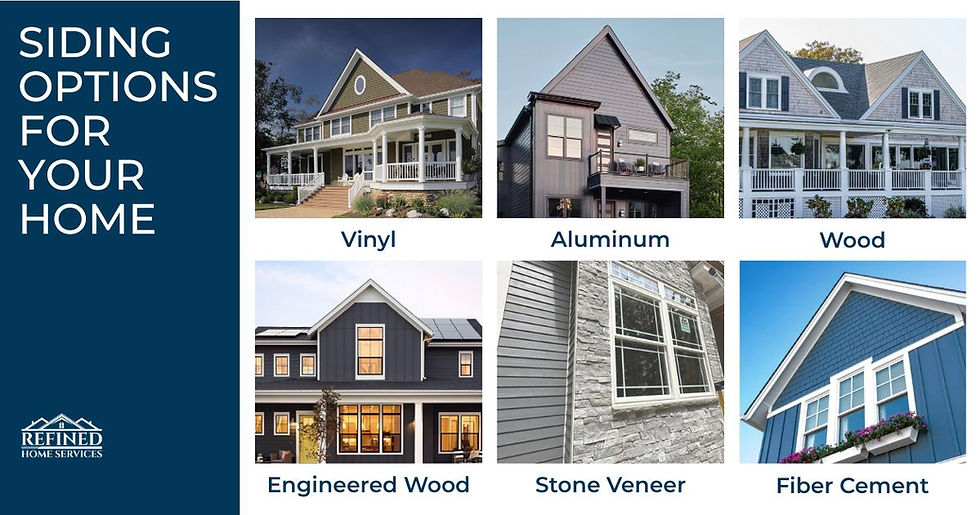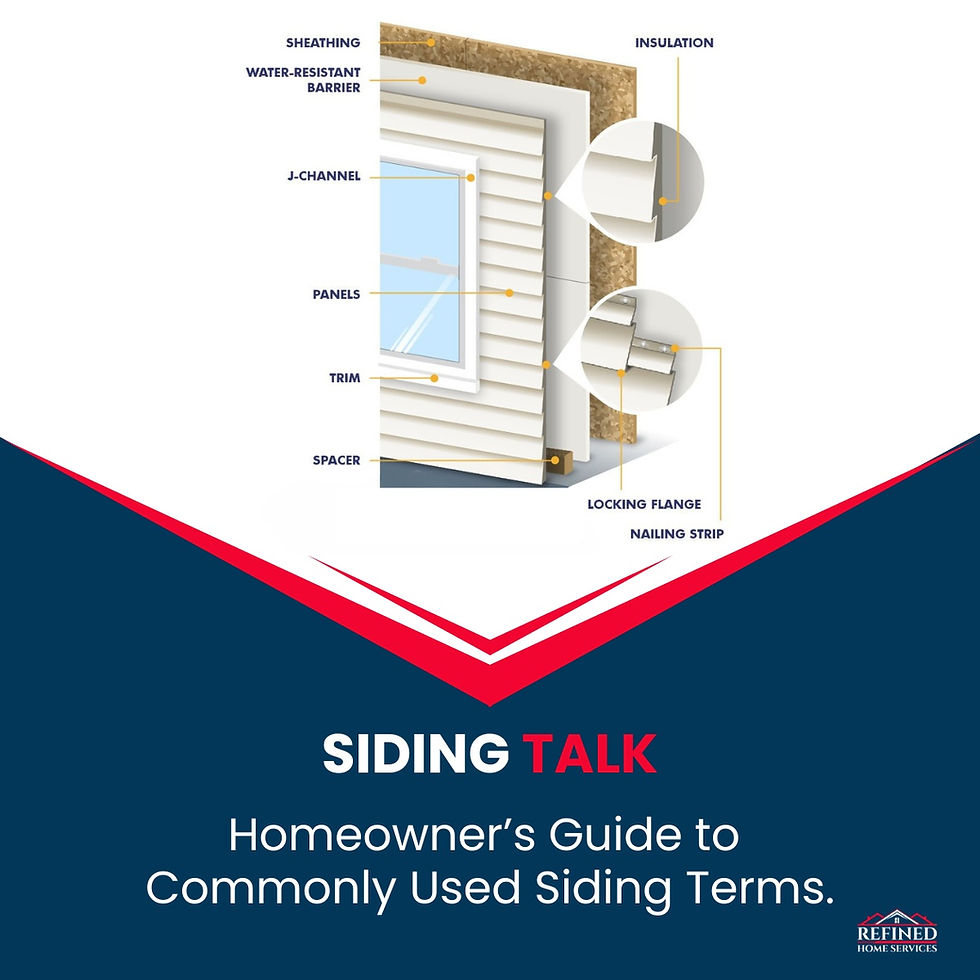Siding Glossary: Homeowner’s Guide to Common Siding Terms
- Refined Home Services

- Jul 9
- 6 min read
Updated: Sep 12
What’s the Best Siding for My Home?
Choosing new siding for your New England home is one of the most impactful decisions you can make. Not only does it affect your home’s curb appeal and energy efficiency, but it also plays a major role in its ability to withstand the region’s unique weather patterns—think blustery nor’easters, icy winters, salty coastal air, moist lake regions, and humid summers. If you’re considering a siding project, understanding the industry terminology can help you feel more confident and informed throughout the process.
This siding glossary is designed with New England homeowners in mind. Whether you’re updating a charming Cape in Massachusetts, a historic Colonial in New Hampshire or a coastal home in Maine, this guide covers the essential terms you’ll encounter when researching or talking to contractors about siding.

Siding Materials and Styles
Aluminum Siding
A lightweight, metal siding option known for its fire, insect, and moisture resistance. It comes in various colors and can mimic wood. While generally low-maintenance, older versions may dent or chalk and fade. Newer products offer improved finishes and greater durability.
Brick Veneer Siding
Brick siding is a non-structural exterior covering for a building that provides the aesthetic appeal and many benefits of traditional brick without bearing the structural load. Unlike solid brick construction, which uses multiple layers of brick as part of the building's structural support, brick siding is a single layer of brick (or material designed to look like brick) attached to the main structural frame (typically wood or steel).
Cedar Siding
A beloved aesthetic for Cape Cod and coastal homes, cedar shingles offer rustic charm and natural weather resistance. They weather to a silver-gray tone, blending beautifully with the New England landscape, but require upkeep to prevent rot or mold.
Wood Siding
Traditional wood siding is characterized by long, horizontal boards that overlap. Common in historic New England homes, clapboard gives a classic appearance but requires regular maintenance and painting.
Engineered Wood Siding
Products like LP® SmartSide® combine wood fibers and resins for a durable, wood-look alternative that's treated to resist fungal decay and insects. It’s lighter and often easier to install than fiber cement and offers strong sustainability credentials.
Fiber Cement Siding
Made from a mix of cement, sand, and cellulose fibers. Brands like James Hardie are popular in New England for their durability, resistance to rot and insects, and ability to mimic wood. It withstands the region’s temperature fluctuations and varying moisture levels well.
Vinyl Siding
Vinyl siding, like options from CertainTeed, offers a cost-effective and low-maintenance solution for your home's exterior. This plastic-based material naturally resists moisture and insects. While extreme temperature shifts, particularly in New England winters, can challenge older or improperly installed vinyl, modern versions are engineered for greater durability. Additionally, newer vinyl siding offers enhanced insulation and superior color retention, making it a more robust and energy-efficient choice for today's homes.

Siding Construction & Installation Terms
Battens
Vertical trim pieces are used to cover seams between wide siding boards or panels, most commonly in board-and-batten siding. Battens create a distinctive architectural style and also help seal joints to protect against water intrusion.
Drip Cap / Head Flashing
A piece of flashing is installed above windows, doors, and trim to direct water away and prevent leaks behind siding.
Fascia
This trim board runs horizontally along the roof edge and meets the top of the siding. Fascia creates a clean visual line and supports gutters, while also protecting the exposed ends of rafters from the elements.
Flashing
Thin metal (aluminum or galvanized steel) pieces are used to redirect water away from seams and penetrations, which is essential for preventing water intrusion.
Frieze Board
A horizontal trim board is installed where the top of the siding meets the soffit or eaves. It fills the gap between the siding and roof overhang, creating a polished transition between vertical siding and horizontal rooflines.
Gable
The upper triangular section of a wall that sits between the two sloping sides of a roof. In siding projects, gables are typically finished with horizontal, vertical, or shingle-style siding to match or accent the rest of the home’s exterior.
House Wrap
A common type of Water-Resistant Barrier (WRB) that provides wind and water resistance while remaining breathable.
J-Channel
A trim piece shaped like the letter “J” used to hold the ends of vinyl or metal siding around windows, doors, and soffits, allowing for expansion and contraction.
Sheathing
The structural layer, usually plywood or oriented strand board (OSB), is attached to the exterior framing of your house. Siding is applied over the sheathing.
Starter Strip
The first piece installed at the base of the wall anchors the initial row of siding and keeps it straight.
Still (Sill) Gasket
A compressible strip (usually foam or rubber) is placed under the sill plate (bottom of the wall framing) to create an air and moisture seal where the framing meets the foundation.
Trim Spacer
A thin strip or shim used behind trim pieces to create consistent spacing or to help siding sit flush when materials of varying thicknesses meet.
Vapor Barrier
A material (often installed on the interior wall) that restricts water vapor from entering the wall cavity. Vapor barriers help manage condensation, especially in cold New England winters.
Water-Resistant Barrier (WRB)
Also known as a house wrap (like Tyvek®), this layer goes over the sheathing and under the siding to prevent water infiltration while allowing moisture vapor to escape.
Siding Performance, Durability & Energy Terms
Breathability
Refers to how well siding materials allow water vapor to escape from within the walls. Breathable systems help prevent mold and rot in New England’s humid summers.
Fade Resistance
UV rays can cause fading of siding over time. Brands like CertainTeed and James Hardie offer advanced color technology and long-term warranties to maintain vibrancy.
Impact Resistance
Important for homes in wooded or coastal areas where hail, wind-blown debris, or falling branches are a concern. Engineered wood and fiber cement both offer high impact resistance.
Maintenance Level
Some siding requires repainting (like wood), while others need only occasional rinsing (like vinyl or fiber cement). Knowing the long-term care needed for each type can help you plan ahead.
R-Value
A measure of insulation effectiveness. While siding alone has low R-values, insulated siding options (like insulated vinyl or foam-backed panels) can improve energy efficiency and reduce heating costs—a big plus in colder climates.
Soffits
Connected to the siding at the top of the wall, soffits enclose the underside of roof eaves. In a siding system, they provide ventilation for the attic and prevent moisture buildup while giving the home a finished edge where the wall meets the roofline.
Sustainability & Lifespan
Cradle-to-Cradle Certification
A sustainability certification that considers the full life cycle of a product. Look for third-party certifications if eco-friendliness is a priority.
Lifespan
Vinyl siding: Between 20 and 40 years
Natural wood siding: Between 20 and 40 years
Engineered wood siding: Between 20 and 30 years
Stucco siding: Between 50 and 80 years
Brick siding: 80 to 100 years
Fiber cement siding: 50 years and above
Recycled Content
Some siding products incorporate post-consumer recycled materials, contributing to a smaller environmental footprint. LP® SmartSide® products are often praised for using sustainable forestry practices and carbon-negative manufacturing.
Return on Investment
For New England homeowners, replacing existing siding is a wise investment that enhances curb appeal and offers a substantial return. The most recent Journal of Light Construction's Cost vs. Value report lists fiber cement as a top performer in the region, with a 118.3% return on investment. In comparison, vinyl siding typically recoups 115.8% of its initial outlay.
Final Takeaway for New England Homeowners
Understanding the entire siding system, from the sheathing and barriers behind the walls to the visible boards, trims, and flashing, is crucial for making informed decisions. Whether you're restoring a historic farmhouse or upgrading your coastal bungalow, understanding these terms helps you communicate effectively with your contractor and ensure your home is protected for decades to come.
Need help selecting the right system for your home? A trusted local contractor like Refined Home Services can walk you through the process, recommend materials suited to New England’s tough climate, and ensure every layer of your siding system performs as beautifully as it looks.


